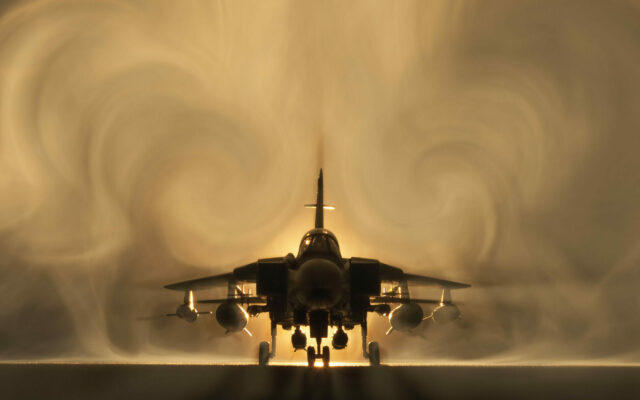One of the Balloons the Military Shot Down May Have Belonged to A Local Ballooning Club!

President Biden talked yesterday about the three balloons the military shot down last weekend over Alaska, Canada, and Michigan. He said there’s no evidence they were Chinese spy balloons like the one we shot down two weeks ago. He said, “These three objects were most likely balloons tied to private companies, recreation, or research institutions studying weather.”
Now we MIGHT know where at least one of those balloons came from: the “Northern Illinois Bottlecap Balloon Brigade”!
It’s a club for balloon hobbyists. The name is a reference to a scene in the movie “Up”, where the old man gives the kid a merit badge that’s really a bottlecap. (Here’s the scene.)
The group launches small balloons with trackers on them, just so they can track them as they float around the world. And they’re very basic. They usually cost between $12 and $180, as opposed to the missile used to bring down the balloon, which is near a half million dollars!
The $12 versions are basic Mylar balloons, like the kind you’d buy at a party store. Dozens are up there at any given time, and they sometimes circle the Earth several times before they come down. They weigh less than six pounds, so they’re allowed by the FAA.
The Bottlecap Balloon Brigade says they lost contact with one of their balloons on February 10th near Alaska. That’s also when the military used a Sidewinder missile to shoot something down in the same area.
The Balloon Brigade’s balloon was floating at around 39,000 feet, which is also about right. So the circumstantial evidence adds up, but the government hasn’t confirmed anything yet.
By the way, another one of these hobby balloons is set to enter U.S. airspace TODAY. So stayed tuned. There’s also a chance it could pass over Mexico.
Here’s the statement from the NIBBB on their website:
We at the Northern Illinois Bottlecap Balloon Brigade are excited to see the recent interest in our hobby. The goal of our group is to share factual and technically correct information about pico balloons and the flights of those that we launch. Our desire is to continue pursuing that goal in the midst of all this.
There has been particular interest in one of our pico balloons, one that transmits call sign K9YO. As noted on our “Locate and Track” page and blog, the last transmission from that balloon received and reported to the WSPR system was on February 11, 2023, and indicated that balloon was near Hagemeister Island, off the southwest corner of Alaska. Since we have not found a transmission from that balloon since that time, we have declared it “Missing In Action”, as we have with previous flights. At that time, K9YO had circumnavigated the globe 6 times and was nearing the completion of a 7th lap. Unfortunately, that’s where the factual information on its location ends.
At that time and as we often do, we used NOAA’s HYSPLIT model to predict where the balloon may go from there. (The graphical output of that model can also be seen on the “Locate and Track”.) It’s important to note that this is a model, the output of which is dependent on the quality of the inputs we provide and predicted weather information. There are plenty of instances in our own experience where the model inaccurately predicted the path. Therefore, using that model output as a sole means of asserting the balloon’s position at a point in time is not supported.
Additionally, it is not unusual for significant periods of time to elapse between received transmissions. This is due to a variety of factors. At the latitude of K9YO’s flight, available sunlight to illuminate the solar panels is a big one. To account for this factor, we’ve experimented with a variety of solar panel configurations. Since it was launched on October 10, 2022, there have been several periods, one as long as 30 days, in which we did not receive a transmission from pico balloon K9YO.
As has been widely reported, no part of the object shot down by the US Air Force jet over the Yukon territory has been recovered. Until that happens and that object is confirmed to be an identifiable pico balloon, any assertions or claims that our ballon was involved in that incident are not supported by facts.
Please note that we construct and launch our balloons in accordance with applicable regulations, as described in this blog post. This includes compliance with FCC regulation regarding radio transmission from the balloons. The call signs used in these transmissions are assigned to General or Amateur Extra class licensees within our group who have passed the requisite exams and are registered with the FCC. (If you’re interested in amateur radio, we’d encourage you to check out HamStudy.org for more information about the hobby and how to get licensed.)
We track all of our balloons daily. We have systems to notify us when new transmissions are received and reported. We regularly post to the blog on the progress of those flights, including our pico balloon currently in flight around Antarctica. We invite anyone to follow our blog to receive notification of those posts, including any updates on the flight of pico balloon K9YO.
At this time, no members of our group are giving or are planning to give interviews.
We have temporarily disabled comments on our site. The volume was overwhelming for our small group.
— The members of the Northern Illinois Bottlecap Balloon Brigade






